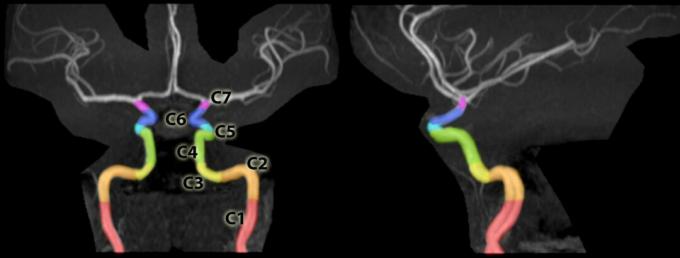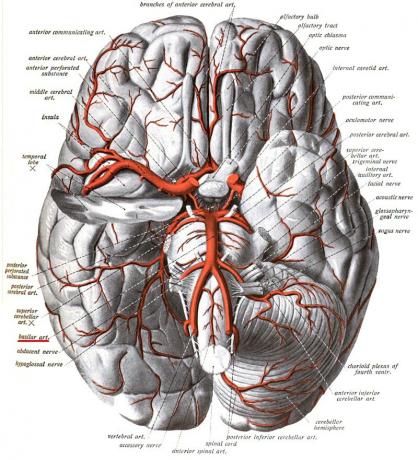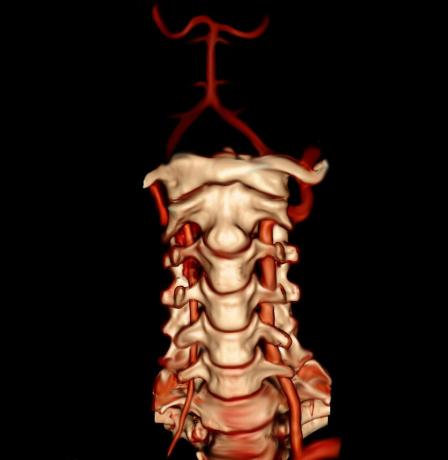Vascularization of the Central Nervous System: characteristics and structure
Our brain needs to receive a constant and solid blood supply loaded with nutrients and oxygen, since it does not have the capacity to store energy from food that we ingest.
This is possible thanks to a correct vascularization of the central nervous system (CNS), which is made up of a complex interconnection of arteries and blood vessels that run throughout the spinal cord and brain.
The vascularization of the CNS allows, in addition to providing nutrients and oxygen to the brain, that this and each of its parts can develop their functions.
Before detailing what the functions of the vascularization of the central nervous system consist of we will comment, as a summary, the types of arteries of which the nervous system is composed central.
- Related article: "Parts of the Nervous System: anatomical structures and functions"
Arteries of the Central Nervous System
The vascularization of the central nervous system (CNS) is possible thanks to the arteries that reach different areas that make up its structure.
To receive this blood supply, so necessary in the brain, there are two arterial groups that are responsible for it, coming from the heart and through the aorta artery, thus allowing the maintenance of the metabolic activity of the organism.
On one side are the vertebral arteries, which are responsible for supplying the caudal or posterior area of the brain; joining together to make up the basilar artery which, in turn, forms the posterior cerebral artery. These are responsible for supplying blood to the brain stem and cerebellum.
On the other are the internal carotid arteries, which have the task of supplying the rostral or frontal area of the brain, forming the anterior and middle cerebral arteries. These arteries are divided into smaller branches that spread through the subarachnoid space or leptomeningeal space and are enter the brain tissue in order to ensure that it is provided with the necessary nutrients for its correct functioning.
The aforementioned arteries can also be of two types. One type is the one made up of the conduction ones, which are directed towards the lateral surfaces of the brain, and the other type is the one that is made up of the perforators., which come from the conduction arteries in order to supply more specific areas.
There is an area where the basilar artery and the carotid arteries connect, a structure called Willis polygon, which is the area found in the lower part of the brain and in which the internal carotid arteries are branched into smaller arteries, the latter being the ones that are responsible for supplying oxygen-laden blood to 80% of the brain.
- You may be interested in: "Erythrocytes (red blood cells): characteristics and function"
The vascularization of the spinal cord
The area of the central nervous system, called the spinal cord, is divided into the following segments, like the vertebral column: cervical, thoracic, lumbar, sacrum, and coccygeal. Each and every one of these segments is responsible for providing eight pairs of spinal nerves that start from the spinal canal.
Correct functioning of the spinal cord and all its segments is essential for the correct functioning of the spinal cord. vascularization through the arteries and venous ducts that run through it, as will be explained in more detail in continuation.
1. Blood supply to the arteries of the spinal cord
The spinal cord is the area of the central nervous system that is responsible for transmitting incoming and outgoing messages from the brain to the rest of the body. Now, for a correct operation, it is crossed by three longitudinal arterial vesselsThese being the anterior spinal artery and the two posterior spinal arteries.
This anterior spinal artery originates from the two vertebral arteries that are at the level of the medulla oblongata, also known as the medulla oblongata, and runs down through the anterior or frontal surface of the marrow.
On the other hand, the posterior spinal arteries, which emerge from the vertebral arteries or in the posterior inferior cerebellar arteries and depart towards the caudal or posterior surface of the marrow.
The arteries of the medulla, previously mentioned, need to be reinforced by the radicular arteries, such as the ascending cervical arteries, the intercostals and the lumbar, in order to be able to supply blood through the medulla, from the part that is below the segments cervical.
A disorder produced in the blood supply to the spinal cord of the CNS, such as an occlusion in the anterior spinal artery, favors the well-known as “acute thoracic spinal cord syndrome” that entails paraplegia and incontinence, also losing sensitivity to temperature and pain.
- Related article: "Spinal cord: anatomy, parts and functions"
2. Drainage of the venous ducts of the spinal cord
The drainage action of the venous ducts of the spinal cord occurs through a pattern similar to that of the arterial supply to this area. For it, there are six interconnected venous ducts that are longitudinally expanded through the spinal cord.
These ducts constitute the anterior and posterior spinal veins; both extended to the middle area. On the other hand, there are the anterolateral veins and the posterolateral veins that are close to the insertion of the anterior and posterior venous roots.
All these blood vessels are responsible for draining, through the anterior and posterior radicular veins, to the epidural venous plexus, also known as the internal vertebral venous plexus, which is located between the vertebral peristyle and the dura mater, which is the outer layer that covers and protects both the brain and the spinal cord spinal.
In addition, the internal venous plexus is in communication with the external vertebral venous plexus, which is why it is interconnected with the ascending veins of the lumbar area and with the azygous and hemiazygous veins, which fulfill a special function by providing a route alternative for blood circulation to the right atrium of the heart, if a situation arises in which the other cavas.
- You may be interested in: "Circulatory system: what is it, parts and characteristics"
The vascularization of the brain
The part of the central nervous system known as the brain is made up of three main areas: the brain, the cerebellum, and the brain stem. All these areas are at full capacity thanks to a correct vascularization.

1. The blood supply to the arteries of the brain
The part of the central nervous system known as the brain is supplied by two pairs of blood vessels, better known as the internal carotid arteries and the vertebral arteries.
Internal carotid artery
The internal carotid artery It is divided between two arteries known as the anterior and middle cerebral.
The anterior cerebral artery passes over the optic nerve and subsequently crosses the longitudinal fissure between the two cerebral hemispheres, following the curvature of the hard body, until it irrigates the medial area of the frontal and parietal lobes. It also joins the blood vessel on the opposite side through the anterior communicating artery. That is why the anterior cerebral artery is responsible for supplying the cerebral areas of the motor and sensory cortex of the lower limb (the legs).
The middle cerebral artery, being the largest of the three arteries of the brain, has a cortical territory of greater extension than the others. Starting from the place where it originates, it continues until it penetrates the lateral sulcus of the brain, where it is divided so that its branches are in charge of irritating the lateral zone of the temporal, parietal and frontal.
This entire surface encompasses the primary motor and sensory cortices of the entire body, with the exception of the lower limb. In addition, it is in charge of irrigating the auditory cortex and the insula, located deep in the lateral sulcus of the brain.

- Related article: "The 7 differences between arteries and veins"
Vertebral artery
The vertebral artery arises from the subclavian artery, rising towards the transverse foramina, located in the cervical vertebrae, until entering the skull cavity, passing through the foramen or foramen magnum.
In this journey, the vertebral artery branches into arteries called the anterior and posterior spinal arteries, which are responsible for supplying the spinal cord and brainstem.
Among all these ramifications there is a branch that stands out above the rest as it is larger; it is known as the posterior inferior cerebellar artery, whose function is to irrigate the lower part of the cerebellum.
When crossing the rostral or frontal zone, the two vertebral arteries unite in the area of the medulla oblongata, conforming basilar artery.

This basilar artery is branched in turn so that it supplies multiple areas, between the which include the lower and anterior parts of the brain, through the cerebellar artery previous; also the inner ear, through the labyrinth artery.
The basilar artery is also subdivided between the superior cerebellar arteries and the posterior cerebral arteries.. The superior cerebellar is in charge of supplying the upper layer of the cerebellum, while the posterior cerebral has the task of irrigating the inferomedial aspect of the temporal lobe, as well as the visual cortex of the lobe occipital.
In composition, the irrigation of the brain by the vertebral and basilar arteries has been called the “vertebrobasilar system”. All this comprises a vascular network located at the base of the brain, the aforementioned polygon of Willis, also called the arterial circuit of the brain.

2. Drainage of the venous ducts of the brain
For the drainage of this part of the central nervous system there are three vessels that allow it: the venous sinuses, the superficial veins and the deep veins.
The deep and superficial cerebral veins are responsible for draining the venous sinuses, located in the layer known as dura, and they are some pathways that are formed between the two leaves of the dura mater and that in turn are subdivided between:
- Superior sagittal sinus: in charge of receiving blood from the superior cerebral veins.
- Inferior sagittal sinus: through which the veins located on the medial face of the hemispheres are drained.
- Straight sinus: in whose area the deeper structures of the forebrain are drained, in addition to the inferior sagittal sinus.
The deep cerebral veins, in turn, fulfill the function of draining the structures located in the internal part of the forebrain. Noteworthy are the choroidal veins and the thalamostriate, which are responsible for draining the thalamus, the basal ganglia, the hippocampus, the choroid plexus and the inner capsule.
These veins unite in such a way that they make up the internal cerebral vein and, in addition, the two internal cerebral veins form the great cerebral vein or Galen, located in the lower part of the corpus callosum, continuing through the straight sinus, located in the cerebellum and responsible for draining the internal jugular vein that receives blood from the face, neck and brain.
Superficial veins are located in the subarachnoid space and its function is to drain the lateral surface of both cerebral hemispheres, until reaching the superior sagittal sinus.

Damage to the vascularization of the central nervous system
Stroke is produced when the vascularization of the brain is interrupted, being what is equivalent in the brain to a myocardial infarction in the heart. This causes damage that may be irreversible to the person who suffers it.
As mentioned above, the brain needs to receive nutrients and oxygen through the circuit that makes up the vascularization of the central nervous system; Therefore, if this vascularization is interrupted, brain cells begin to fail, even dying and can cause what is known as stroke or cerebral stroke.
This occurs most of the time by blockage of one of the blood vessels And, therefore, as there is a lack of oxygen, this hinders the correct physical and mental functioning of the person, which can lead to serious damage. Also, with the help of professionals, you can gradually recover the affected functions and even relearn skills.
The best known habits to prevent a stroke are controlling blood pressure and cholesterol levels, as well as avoiding smoking.
